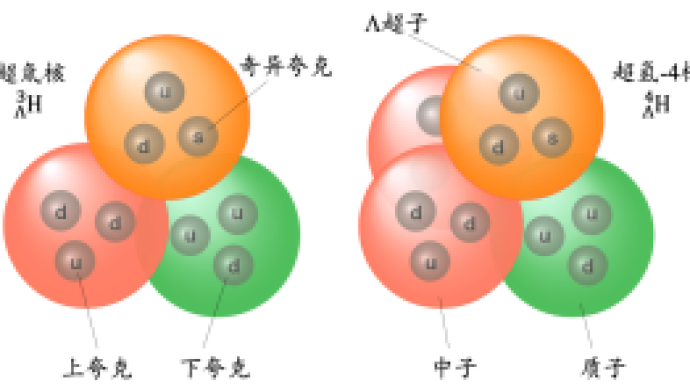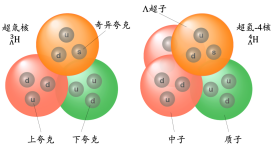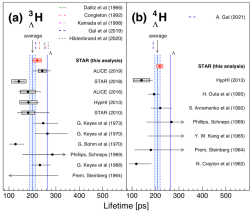
Recently, the high-energy nuclear physics team of the University of Science and Technology of China has made important progress in supernuclear research. 

The basic units that make up the nucleus of an atom are nucleons, namely neutrons and protons. However, scientists have found that some atomic nuclei also have hyperons inside. Unlike ordinary nucleons, hyperons are baryons with singular numbers. In the Standard Model theory of modern particle physics, a baryon is a composite particle consisting of three quarks (or three antiquarks that make up antibaryons).
The bound state formed by hyperons and nucleons is the hypernucleus. How to form bound states through interaction between nucleons and hyperons has always been a frontier fundamental problem in the field of nuclear physics. In astronomy, whether hyperons also exist in the dense core of neutron stars, and in the extremely dense environment, the interaction between hyperons and nucleons, and the connection between the equation of state of neutron stars are all hot issues in the field of nuclear physics and astrophysics. .
The hypernucleus is regarded as a natural "laboratory" for the study of hyperon-nucleon interactions, and is the main object of research in the aforementioned fields. Theoretically, the hypernucleus composed of hyperons and nucleons is a weakly bound system, and the lifetime of the light hypernucleus should be close to that of free Lambda (symbol Λ) baryons.
In the STAR experiment at the Relativistic Heavy Ion Collider (RHIC), the nuclear matter system generated in the low energy region has a higher density of baryons, which is favorable for the generation of supernuclei. The STAR experiment measured the supernuclear lifetime at the center of mass energies of 3GeV and 7.2GeV, and obtained the most accurate experimental results, which were found to be about 20% shorter than the lifetime of free Lambda baryons, which provided precise insights for further understanding of supernuclear interactions. experimental data.
The main authors of the aforementioned collaborative group papers include Zhang Yifei, a professor of the High Energy Physics Group of the University of Science and Technology of China, and a doctoral student, Li Xiujun, who have made important contributions to the experimental and physical analysis work. The aforementioned research was funded by the National Natural Science Foundation of China, the Ministry of Science and Technology and other units.

Schematic diagram of the structural composition of the supertritium nucleus and the superhydrogen-4 nucleus, the picture comes from the University of Science and Technology of China
The aforementioned USTC team cooperated with the Lawrence Berkeley National Laboratory (LBNL) and Brookhaven National Laboratory in the United States to achieve the RHIC-STAR mass center energy 3GeV (GeV is one billion electron volts) and 7.2GeV in the heavy ion targeting experiment. The most accurate measurement of the lifetimes of hypertriton (H3L) and hyperhydrogen-4 (H4L) nuclei to date, and the first measurement of the yields of these two types of hypernuclei at 3GeV energy. The results were published in Physical Review Letters.
Image via Physical Review Letters
It is reported that RHIC-STAR is a large-scale international cooperation group based on the STAR experiment at the Relativistic Heavy Ion Collider (RHIC) at Brookhaven National Laboratory in the United States. It is currently composed of 753 researchers from 70 units in 14 countries.The basic units that make up the nucleus of an atom are nucleons, namely neutrons and protons. However, scientists have found that some atomic nuclei also have hyperons inside. Unlike ordinary nucleons, hyperons are baryons with singular numbers. In the Standard Model theory of modern particle physics, a baryon is a composite particle consisting of three quarks (or three antiquarks that make up antibaryons).
The bound state formed by hyperons and nucleons is the hypernucleus. How to form bound states through interaction between nucleons and hyperons has always been a frontier fundamental problem in the field of nuclear physics. In astronomy, whether hyperons also exist in the dense core of neutron stars, and in the extremely dense environment, the interaction between hyperons and nucleons, and the connection between the equation of state of neutron stars are all hot issues in the field of nuclear physics and astrophysics. .
The hypernucleus is regarded as a natural "laboratory" for the study of hyperon-nucleon interactions, and is the main object of research in the aforementioned fields. Theoretically, the hypernucleus composed of hyperons and nucleons is a weakly bound system, and the lifetime of the light hypernucleus should be close to that of free Lambda (symbol Λ) baryons.
In the STAR experiment at the Relativistic Heavy Ion Collider (RHIC), the nuclear matter system generated in the low energy region has a higher density of baryons, which is favorable for the generation of supernuclei. The STAR experiment measured the supernuclear lifetime at the center of mass energies of 3GeV and 7.2GeV, and obtained the most accurate experimental results, which were found to be about 20% shorter than the lifetime of free Lambda baryons, which provided precise insights for further understanding of supernuclear interactions. experimental data.

Lifetime measurement results of supertriton and superhydrogen-4 nuclei, the picture comes from the University of Science and Technology of China
At the same time, STAR also measured the yield of supernuclei at 3GeV for the first time, and found that it was significantly higher than the results measured in the high-energy region (2.76TeV, TeV is 10 to the 12th electron volt), indicating that the low-energy and high baryon density region is more suitable for studying exotic nuclei. Advantage. The experimental results are consistent with the hadron transport model, which provides an important experimental basis for understanding the generation mechanism of supernuclei in the low-energy region. Among them, hadrons are subatomic particles affected by strong interactions, including baryons and mesons.The main authors of the aforementioned collaborative group papers include Zhang Yifei, a professor of the High Energy Physics Group of the University of Science and Technology of China, and a doctoral student, Li Xiujun, who have made important contributions to the experimental and physical analysis work. The aforementioned research was funded by the National Natural Science Foundation of China, the Ministry of Science and Technology and other units.
Related Posts
0 Comments
Write A Comments